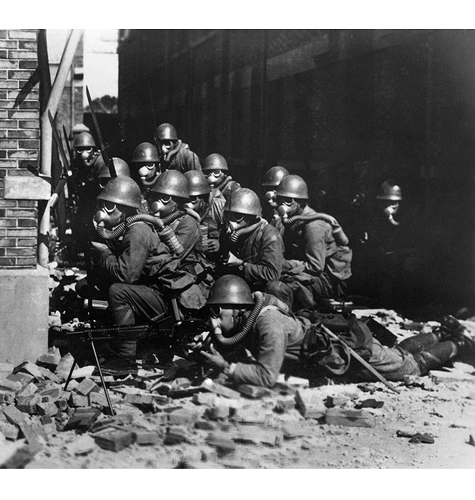C.4 NERVE AGENTS
C.4.1–C.4.5 Tabun (GA), Sarin (GB), Soman (GD), GF, and VX Nerve agents are among the deadliest of chemical agents and many produce rapid symptoms. They include the G- and V-agents. Examples of Gagents are tabun (GA), sarin (GB), soman (GD), and GF. A V-agent is VX. In some countries “VF” agents are known as “A” agents.
Nerve agents can be dispersed by artillery shell, mortar shell, rocket, land mine,
missile, aircraft spray, and aircraft bomb or bomblet. They could also be carried by
a terrorist in the form of an aerosol tank or can.
.
Signs and Symptoms:
Vapor:
Small Exposure: miosis, rhinorrhea, mild difficulty breathing.
Large Exposure: sudden loss of consciousness, convulsions, apnea, flaccid paralysis, copious secretions, miosis.
Liquid on Skin: Small to Moderate Exposure: localized sweating, nausea, vomiting, feeling of weakness.
Large Exposure: Sudden loss of consciousness, convulsions, apnea, flaccid paralysis, copious secretions.
Detection: M256A1, CAM, M8 paper, M9 paper, M8A1 and M8 alarm systems.
Decontamination: M291, M258A1, hypochlorite, large amounts of water.
Management: Administration of Mark I kits (atropine and pralidoxime chloride); diazepam in addition if the casualty is severe; ventilation and suction of airways for respiratory distress.
.
Overview
Nerve agents are the most toxic of known chemical agents. They are hazards in their liquid and vapor states and can cause death within minutes after exposure. Nerve agents inhibit acetylcholinesterase in tissue, and their effects are caused by the resulting excess acetylcholine.
.
History and Significance
Nerve agents were developed in pre–World War II Germany. Germany had
stockpiles of nerve agent munitions during World War II but did not use them for
reasons that are still unclear. In the closing days of the war, the United States and
its allies discovered these stockpiles, developed the agents, and manufactured nerve
agent munitions. The U.S. chemical agent stockpile contains the nerve agents sarin
(GB) and VX.
Nerve agents are considered major military threat agents. The only known
battlefield use of nerve agents was in the Iraq–Iran conflict. Intelligence analysts
indicate that many countries have the technology to manufacture nerve agent
munitions.
Medical Management
Management of a casualty with nerve agent intoxication consists of
decontamination, ventilation, administration of the antidotes, and supportive
therapy. The condition of the patient dictates the need for each of these and the
order in which they are done. Decontamination is described in Chapter 6. Skin
decontamination is described elsewhere in this manual. Skin decontamination is not
necessary after exposure to vapor alone, but clothing should be removed because it
may contain trapped vapor.
The need for ventilation will be obvious, and the means of ventilation will
depend on available equipment. Airway resistance is high because of
bronchoconstriction and secretions, and initial ventilation is difficult. The resistance
decreases after atropine administration, after which ventilation will be easier.
Three drugs are used to treat nerve agent exposure, and another is used as
pretreatment for potential nerve agent exposure. The three therapeutic drugs
are atropine, pralidoxime chloride, and diazepam. The drug pyridostigmine
bromide is used in the pretreatment for nerve agents.
Atropine: Atropine is a cholinergic blocking or anticholiner-gic compound. It is
extremely effective in blocking the effects of excess acetylcholine at peripheral
muscarinic sites.
Pralidoxime chloride: Pralidoxime chloride is an oxime. Oximes attach to the
nerve agent that is inhibiting the cholinesterase and break the agent–enzyme bond
to restore the normal activity of the enzyme.
Diazepam: Diazepam is an anticonvulsant drug used to decrease convulsive
activity and reduce the brain damage caused by prolonged seizure activity.
On 4 April 2017, Sarin was initially proposed as the gas used to carry out an attack by the Syrian Assad regime in the village of Khan Shaykhun in Idlib (Syria). The attack has caused more than 60 dead and over 170 injured. According to Russian sources, however, the dispersion of the gas in the air was caused by the bombing that would have been perpetrated by the aviation loyalist a stock of chemical weapons in the hands of the militias of the Islamic State: Words denials by the Turkish sources, indicating instead as Daesh (ISIS) had no chemical storage there. It must also add that – the analysis of films made by rescuers shortly after the incident – were noted several incompatibilities with the use of a gas such as sarin nervico (such as the lack of muscle spasms in still dying victims or rescuers which however are able to work without any problems, despite the absence of caps) which have led to the hypothesis instead the use of a gas with a suffocating effect (eg. chlorine-based and / or phosgene).


Pubblicazione gratuita di libera circolazione. Gli Autori non sono soggetti a compensi per le loro opere. Se per errore qualche testo o immagine fosse pubblicato in via inappropriata chiediamo agli Autori di segnalarci il fatto è provvederemo alla sua cancellazione dal sito








